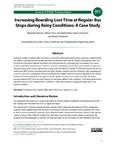Increasing Boarding Lost Time at Regular Bus Stops during Rainy Conditions: A Case Study

Use this link to cite
http://hdl.handle.net/2183/28414
Except where otherwise noted, this item's license is described as Atribución-NoComercial 4.0 Internacional (CC BY-NC 4.0)
Collections
- Investigación (ETSECCP) [826]
Metadata
Show full item recordTitle
Increasing Boarding Lost Time at Regular Bus Stops during Rainy Conditions: A Case StudyAuthor(s)
Date
2021Citation
Novales, Margarita, et al. 2021. Increasing Boarding Lost Time at Regular Bus Stops during Rainy Conditions: A Case Study. Journal of Public Transportation, 23 (1): 63-80. DOI: https://doi.org/10.5038/2375-0901.23.1.4
Abstract
[Abstract] Inclement weather conditions affect the behavior of travelers and transportation system operations. Understanding this influence can help improve operational planning schemes for any mode of transport, especially for buses. One of the factors that can be affected by rainfall is the time expended by a passenger from the moment a bus opens
its doors until he/she boards the bus. This time is known as “boarding lost time” (BLT), and it was first introduced in the latest edition of the Transit Capacity and Quality of Service Manual (TCQSM). TCQSM only considers BLT for bus rapid transit (BRT) stations with more than one berth. Weather conditions are not considered when calculating the current BLT for a BRT system, given the provision of protective shelters over the entire boarding area of such stations. Furthermore, recommendations with regard to BLT for regular bus stops have not been provided. This paper presents analyses of BLT for a two-berth regular bus stop under different rainy conditions. The findings demonstrate that the increment in BLT between Berth 2 and Berth 1 under heavy rainfall is significantly higher than in the absence of rainfall.
Keywords
Boarding lost time
Weather effect
Dwell time
Transit capacity
Bus stops
Weather effect
Dwell time
Transit capacity
Bus stops
Editor version
Rights
Atribución-NoComercial 4.0 Internacional (CC BY-NC 4.0)






